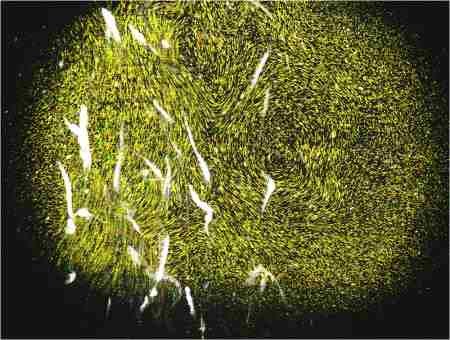Yes, 5 mm Long Shrimps can Modify the World's Ocean Currents
| Ana Verayo | | Oct 01, 2014 08:48 AM EDT |
(Photo : M. M. Wilhelmus and J. O. Dabiri/Caltech) Sea monkeys or tiny brine shrimps can apparently cause giant currents underwater with their collective movement.
Sea monkeys, a type of brine shrimp, can apparently move ocean currents in a manner similar to that of wind and tides work together.
Brine shrimp or Artemia salina are like any other zooplankton that travel in large groups, swimming in an upward and downward motion beneath the ocean surface.
Like Us on Facebook
This movement is caused by the tiny brine shrimp gravitating toward different light conditions. At night, they approach the surface and retreat to deeper sea levels during daytime.
When this movement occurs, this massive motion generates a strong current that can affect ocean circulation and tides on a global scale, said a study from the California Institute of Technology (Caltech).
According to study co-author John Dabiri from Caltech, this movement actually reveals more about how animals regardless their size can displace water that is significantly longer or larger than their body size.
To further study and observe this phenomenon, Caltech researchers placed these sea monkeys in a special aquarium surrounded by lasers. A blue laser was triggered when the tiny shrimp migrated to the surface. A green laser indicated the brine shrimps were swimming in the center of the tank.
The water inside the tank was dotted with tiny silver coated glass spheres that reflected the light from the lasers. This allowed researchers to visually pinpoint the changing movements of the shrimp currents. These currents were filmed by a high speed camera.
Even if a shrimp just measures a mere 5 millimeters long, the collective power from their movement can generate a trillion watts.
This study suggests how microscopic animals influence ocean's currents along with winds. Both affect the ocean's temperature that in turn, provides food and nutrients essential for marine life.
This particular study was published in the journal, Physics of Fluids.
TagsHow Sea Monkeys Control the World's Ocean Currents, zooplankton, seamonkeys, ocean currents, caltech, seamonkeys ocean currents caltech
©2015 Chinatopix All rights reserved. Do not reproduce without permission
EDITOR'S PICKS
-

Did the Trump administration just announce plans for a trade war with ‘hostile’ China and Russia?
-

US Senate passes Taiwan travel bill slammed by China
-

As Yan Sihong’s family grieves, here are other Chinese students who went missing abroad. Some have never been found
-

Beijing blasts Western critics who ‘smear China’ with the term sharp power
-

China Envoy Seeks to Defuse Tensions With U.S. as a Trade War Brews
-

Singapore's Deputy PM Provides Bitcoin Vote of Confidence Amid China's Blanket Bans
-

China warns investors over risks in overseas virtual currency trading
-

Chinese government most trustworthy: survey
-

Kashima Antlers On Course For Back-To-Back Titles
MOST POPULAR
LATEST NEWS
Zhou Yongkang: China's Former Security Chief Sentenced to Life in Prison

China's former Chief of the Ministry of Public Security, Zhou Yongkang, has been given a life sentence after he was found guilty of abusing his office, bribery and deliberately ... Full Article
TRENDING STORY

China Pork Prices Expected to Stabilize As The Supplies Recover

Elephone P9000 Smartphone is now on Sale on Amazon India

There's a Big Chance Cliffhangers Won't Still Be Resolved When Grey's Anatomy Season 13 Returns

Supreme Court Ruled on Samsung vs Apple Dispute for Patent Infringement

Microsoft Surface Pro 5 Rumors and Release Date: What is the Latest?










